13 Types of Whisks Perfectly Crafted With Your Dish in Mind
Author: Anne Cowart | Editor: Omar Alonso
Review & Research: Jen Worst & Chris Miller

Together, all of the different types of whisks are among the most common kitchen utensils that can blend ingredients to get a smooth mixture or incorporate air into the mix.
Generally, a whisk is used to beat eggs, mix cake batter, whip cream, etc. A typical whisk consists of a long narrow handle; usually steel, wood, or plastic, joined with multiple wired loops.
The loops may differ depending on their purpose. Usually, the wired loops are made of metal, but some have plastic wired loops used for nonstick cookware. Further, we will be discussing all common kitchen whisk types to clear all the confusion one may have when comparing them.
13 Types of Whisks
In every household, a typical kitchen item, whisks are familiar to everyone, whether their uses or purposes. However, more than one type of whisk is available for different uses. So, let's dive in and explore the different types of whisks that differ in terms of use.
Balloon Whisk
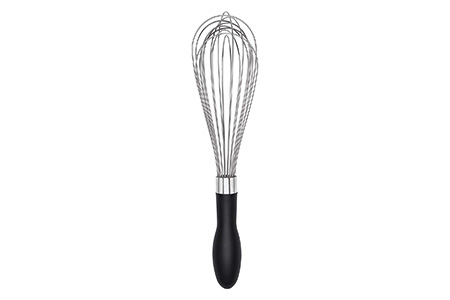
The Balloon whisk or piano whisk contains thin metal wires rounded in a balloon shape, making it very wide and rounded in the end. Also, the flexibility of the wires gives you enough space to work with thin liquid or batters.
The primary function of a balloon whisk is to incorporate air into the mixture as you beat it. A balloon whisk is suitable for beating eggs, whipping cream, making meringue, beating a large batch of egg whites, and lightly mixing dry ingredients instead of sifting.
Due to its vast, oversized shape, the balloon whisk is unsuitable for stirring heavy mixtures. If the wires are strong enough, they might cut through thick batters.
Double-Balloon Whisk
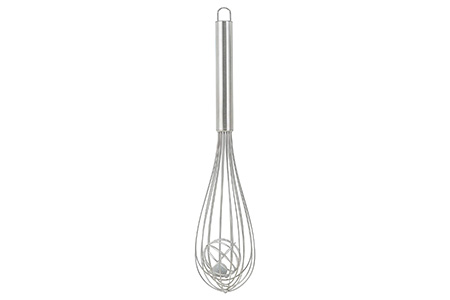
Double-balloon whisk serves the same purpose as the balloon whisk. The significant differences between the double-balloon whisk and balloon whisk are the shape of the wired loops and the dual whisking power.
A wired ball is placed inside the wide balloon shape wired circles, incorporating more air into the mixture with minimal effort. In some designs, the ball is curved from the outer tines; in other words, the inner ball is shaped out from the external wires of the whisk.
The flexible design of these kitchen whisk types give more volume faster. Like a balloon whisk, the double-balloon whisk is fitted for beating eggs, whipping cream, making meringue, etc.
French Whisk
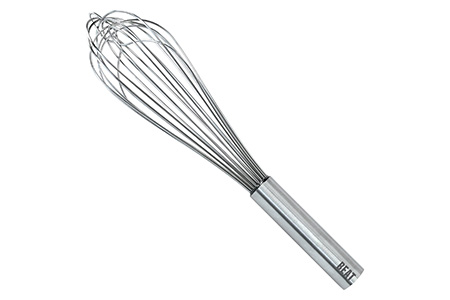
The French whisk has a similar shape to a balloon whisk, except it is narrower in shape, and the tines tend to be straighter than the ones in a balloon whisk. It is less bulbous and stiffer than the balloon whisk.
Because of its taper shape, these types of whisks can be easily used to combine ingredients in smaller containers. Due to its lean structure, the French whisk is not as good as balloon whisks in beating eggs or making meringue, as it cannot incorporate much air into the mixture.
However, unlike balloon whisks, French whisks are perfect for heavy and dense mixes, such as types of frosting, sauces, salad dressing, batters, pancake batter, custards, gravy, etc.
Ball Whisk
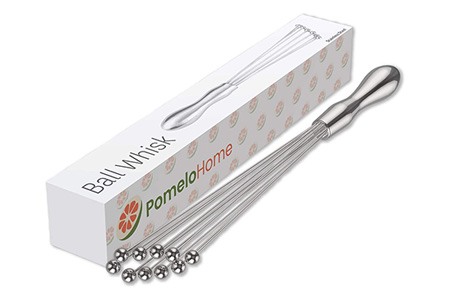
Kettle whisk or ball whisk is an all-purpose whisk easy to clean. It does not have a wired cage-like structure like the balloon or French whisk. Instead, the straight wires have a metal or silicon ball, which acts as an aerator.
The long handle helps you to stir a kettle or a stove pot without risking your hand from getting burnt. Ball whisk is perfect for lighter variety and stirring custards or soup, making sauces, mixing types of mustard, or scrambled types of eggs.
The metal balls in each tine break the ingredient to get a smooth mixture and infuse air into them. The simple design makes it easier to clean than any other whisk.
Cage Whisk
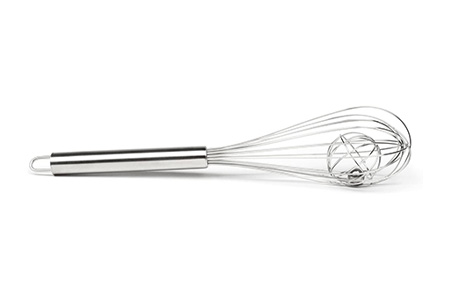
Now for one of the different kinds of whisks you've probably never seen before. The cage whisk has the typical appearance of a balloon whisk but inside of the balloon is a smaller spherical cage of whisk wires.
But that's not all because inside of this cage is a ball bearing big enough to not escape the cage. This ball bearing adds weight to the whisk but also helps to cause whatever thick mixture you're working with to be stirred to a smoother texture and for clumps to be broken up better.
Flat Whisk
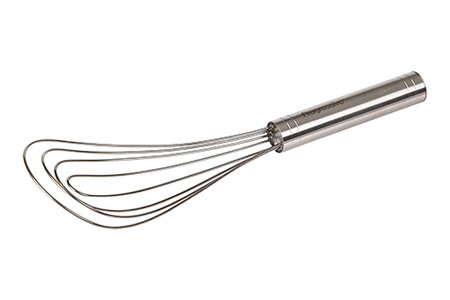
Like its name, the flat whisk or roux whisk is flat in shape. The four wires of the whisk lie flat like a spoon instead of the regular bulbous body. The whisk has a lateral curve, making it easier to scoop ingredients and reach every corner of a pan to stir your mixture well.
This whisk is suitable for stirring sauces in a pan, making a roux, making gravy, removing poached eggs from the water, can be used as a substitute for the fish spatula, and de-glazing your pan. Its single-layered structure makes it easier to clean than the traditional whisks.
Conical Whisk
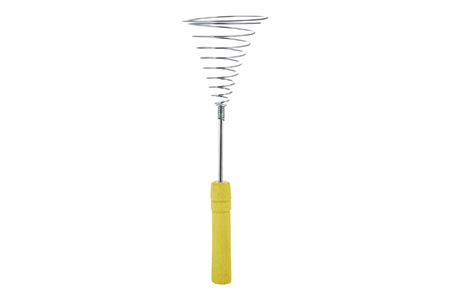
Conical whisks feature long thin wires that form a vast middle and narrow tip. The shape has a strong resemblance to the diamond shape.
The tiny design is designed to reach the corners of any cookware effortlessly. The stiff structure of the conical whisk can substitute a spatula or scraper. These types of whisks can also be used to incorporate the ingredients into a mixture.
Tornado Whisk
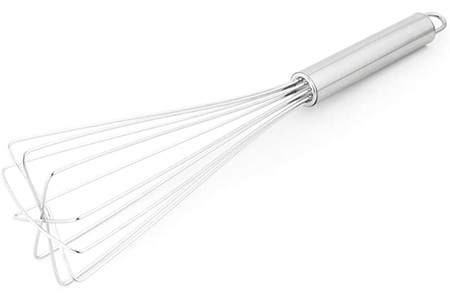
The Tornado whisk contains ragged angular wires. It is suitable for large pans and stove pots, as its flat bottom can sweep the surface and quickly reach the corners. This balloon-shaped whisk with a flattened bottom can be used in sauce or roux.
Furthermore, the tornado whisk is often made of silicone or plastic to be used in nonstick cookware. However, the metal can scrape the Teflon off the nonstick cookware, damaging it.
Dough Whisk
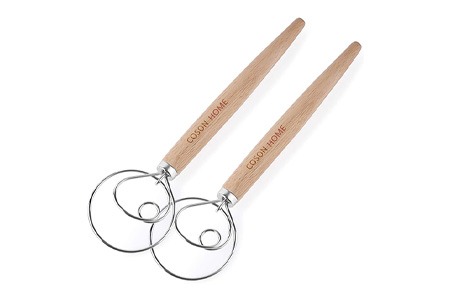
A dough whisk or Danish dough whisk comes in handy for a baker. It is made out of one thick piece of stainless-steel wire, which is curved into a sizeable outer oval, a small inner oval with a small loop, which Alexander Calder designed.
The flat profile of these kitchen whisk types ensure the bakers do not over-knead the dough. The wires are tough enough to cut in through thick dough and blend in ingredients with the rest of the mixture. This whisk is used to blend dough to make pastries, bread, etc.
The dough whisk is ideal for sticky and thick batters, and it makes it easier to mix in chocolate chips or any other add-ins to the cookie dough. The dough whisk is suitable for making all types of brownies, muffins, pancakes, waffles, scones, no-knead bread, etc.
Coil Whisk
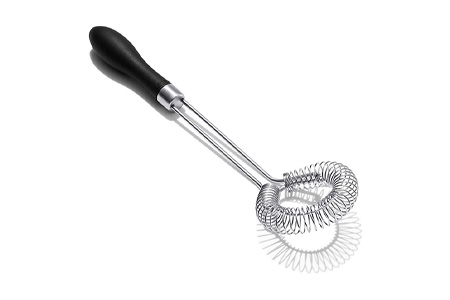
Coil whisk, also referred to as spring whisk, galaxy whisk, and sauce whisk, is not typical in the home kitchen, but it serves a unique purpose. It has small springy wires attached to the handle with a flat bottom, which can be pumped up and down and side to side.
The flattened bottom of these types of whisks can scrape up ingredients or mixtures from the surface or corner of the bowl or pan. Moreover, the coil or spring whisk is applicable for breaking lumps in mixtures.
It is also suitable for cooking gravy, hot chocolate coffee, and hot chocolate milk by adding powdered cocoa. Due to the small size, coil whisk can be used in mason jars, mugs, cups, or bowls of any shape.
Twirl Whisk
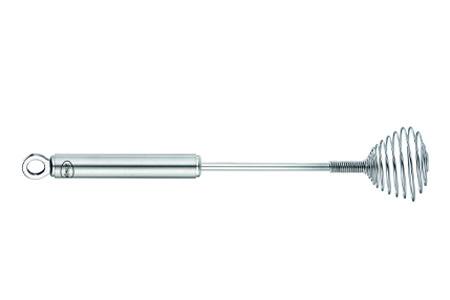
The twirl whisk resembles the coil whisk, mainly used in coffee shops. A springy stainless wire is attached to the handle, which can be pumped up and down. Twirl whisk gives a frothy texture to your latte or milk. It does not have much usage other than this.
Spiral Whisk
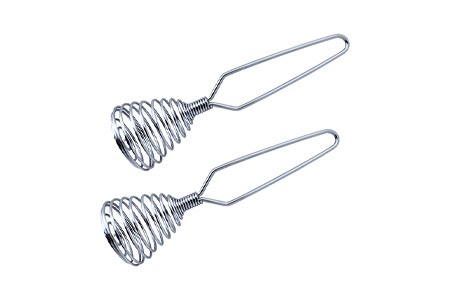
The spiral whisk has a structure almost similar to a coil whisk. The wire is composed of one singular loop, and the looped wire is wrapped in tight coils. It is attached to the handle at a certain angle to rest on the bottom of a flat pan or bowl.
This kitchen whisk types design also makes it helpful in breaking up dry ingredients and an excellent substitute for a balloon or French whisk, which is much bulky in size.
Also, the spiral whisk is appropriate for making gravy, a roux, salad dressing, vinaigrette, sauces, etc. it can also be used to whisk drinks in long cups.
Mini-Bar Whisk
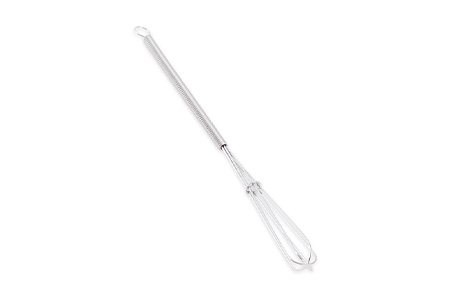
Like its name, a mini-bar whisk is used in bars. Like a balloon whisk, the tines in the mini-bar whisk are looped in a balloon shape. It is wide and rounded in the end, but it is much smaller in size than the balloon whisk.
The small size of these different types of whisks makes it easier to fit into most cocktail glasses. Its size and shape also give a frothy texture to a drink.
Egg whites can be used in drinks, such as gin fizz, white lady, champagne flip, and light and airy cocktails. The balloon whisk design makes it easier to incorporate air into the egg white to get a fluffy and frothy finished product.
Types of Whisks to Perfect Every Dish You Cook
This summarizes our list of different kinds of whisks. If you are searching for a suitable whisk to use in your kitchen, consider the mixture you will use it for and the kind of cookware you will use; for example, never use a metal whisk on nonstick cookware.
Choose the material of the wired loops accordingly; check if the handle is comfortable enough for your grip. It is essential to use the right types of whisks for the job, giving you a better result and taking less time and labor.




